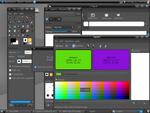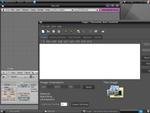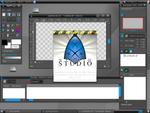Ubuntu Studio 7.04 - The Crowning Jewel of the Ubuntu Family



 Ubuntu Studio 7.04 was finally released yesterday to what seemed like quite a bit of excitement. Ubuntu Studio is a version that focuses on multimedia creation and manipulation with what appears to me as an emphasis on music. At the time of this writing the official website seems to be experiencing a bit of trouble, perhaps due to the high traffic. In any case, sometimes the early bird does gets his worm and this time I was up early.
Ubuntu Studio 7.04 was finally released yesterday to what seemed like quite a bit of excitement. Ubuntu Studio is a version that focuses on multimedia creation and manipulation with what appears to me as an emphasis on music. At the time of this writing the official website seems to be experiencing a bit of trouble, perhaps due to the high traffic. In any case, sometimes the early bird does gets his worm and this time I was up early.
The Install
The downloadable file was a traditional install cdrom image and utilizes the older Ubuntu ncurses interface. It goes throught the basic steps of gathering information such as keyboard and timezone before starting the partitioning phase. There is the choice of guided or manual partitioning methods. Guided will offer the user pre-prepared choice schemes that will likely entail formatting the whole of the harddrive, whereas manual will allow one to use partitions previously in place or set up their drive as desired. The next step is choosing the software packages. In this case one picks from the major categories Music, Video, Plugins, and Graphics. Choosing all three resulted in a 2.5 gig install. There are a few points when one is asked for their input such as desired screen resolution(s), so don't stray too far while the installer works. Then there is the configuration step. This is short and sweet. It consists of setting up a user account and password, setting up the network connection, and a bootloader. One has the choice of a generic or a low-latency kernel. All in all, it probably took the better part of an hour to complete, but then I kept wandering off only to come back to a screen needing input. So actual working time may be less. It's not a difficult installer to navigate, but how it became known far and wide as the most user-friendly still boggles my mind.
The System
The resulting system starts with a lovely silent splash. It consists of this colorful background that kinda reminds me of a fallen Christmas tree after two or three too many eggnogs. It's many different bright spots of color. It does have a nice progress bar and the Ubuntu Studio logo, but in at least my case, both were obstructed by the ugly blue verbose rectangle right in the middle. They should just do away with that and let F2 or <esc> take one to the verbose screen. It just kills the whole effect and given that the font is almost the same shade of blue I can't read the output anyway. Next one logs in at an exceptionally nice gdm theme. Again the same color parade background with the options hidden behind a panel with the Options button where one might usually expect to see a menu start button on a desktop screen. And in fact, that's what one gets when it is depressed. A lovely dark-themed menu with blue highlights containing the usual options of sessions, languages, and actions is found. I was enamored with Ubuntu Studio from this point on.
The gnome splash is a customized and tasteful center focal box. Upon first login I was greeted by the startup sound which indicated to me that perhaps my sound was properly auto-detected and configured. The desktop wallpaper seemed like a let down after the colorful introduction. It's a basic neutral gray abstract with areas of varying darker gray blending in and out. However, given the windows theme, it may have been a logical choice. The windec contains a shiny rounded 3D title bar in dark gray or almost black. The theme colors are medium to darkish gray and blue (with aqua-blue tendencies) highlights and progress bars. Despite my lame description, it is really quite attractive and we will probably have to rely on the screenshots to form an accurate picture. Even with the bland wallpaper, the look and feel of Ubuntu Studio gives one a modern and hip yet tasteful interface. The theme is dark, but yet it doesn't seem to cross the line into "too dark." No discernable eye strain was experienced. Suffice to say it's just really cool looking.
Ubuntu Studio comes with a few window and gdm themes as well as a couple of backgrounds and a nice selection of xscreensavers. Many screensavers worked well under vesa and most of the 3D screensavers, save the gl, worked fairly well under "nv." One item of note is the refreshing sound theme. One has the commonly used startup and logout sounds, but with Ubuntu Studio one has cute little non-obtrusive "clicks" when clicking upon applications in the menu or options such as drop-down boxes in applications. Sounds during interface interaction seems to be a trend of the past and it was refreshing to hear audible indicators again. I'm not sure I ever experienced sound during menu interaction before. It was a nice touch adding polish to the package.
One has the usual Preferences and Administration utilities under the familiar Gnome menus. Accessories include a calculator, simple text editor, disk usage analyzer, a search function, and an online dictionary.
Ubuntu Studio comes with a software/system update tool. An applet appears in the upper panel when updates are available. At the time of testing, there were 13 updates available already. When clicking the applet indicator icon an Update Manager window opens listing all the available updates. One can choose install one, all, none, or any combination of the updates. Clicking "Install Updates" installs the updates. The Update Manager also has a "Check" button that can be used to check for updates at any time. The process of installing the 13 updates completed smoothly with no problems here.
The regular package management utility is Synaptic. For those who may not know, Synaptic is a 3-paned graphical application for installing, upgrading, or removing software packages from one's system. It contains a list of categories, individual packages, and information in those pane. It also has a nice search function. As is usually the case, I had no issues with Synaptic. As with the Update Manager, packages are commonly downloaded from a remote mirror. Ubuntu Studio comes with some sources already defined, but if needed there is a Sources utility to add, subtract, or note any package repositories as well. These can include cdrom or local and remote mirror entries.
The foundation is Linux 2.6.20.15, Xorg 7.2.0, gcc 4.1.2 and Gnome 2.18.1.



Hardware
The time was set correctly which is a process I once took for granted, but since obtaining my notebook pc, this has become a bit iffy. I don't know the technical reasons, but some distros just do not read the bios clock correctly and I commonly get anything from an hour to a day skew in either direction. It's one of those quirks to which one quickly adjusts (by memorizing time protocol mirror addresses) and additionally forms the basis for another testing criteria. My touchpad was responsive and accurate with none of the disappearing, wandering, blinking, or vibrating cursor effects I've experienced with some other distros. As stated above, my sound was automagically configured and working well with the added bonus of, unlike some other distros, a pleasing default sound volume. Many distros default to muted, which is more desirable to the other default extreme sometimes experienced of blowing one's hair back. This is the first time I was able to successfully setup my remote samba printer using the Gnome graphical utility too.
But the news is not all rosy. One of the lesser issues was that X was setup to use "vesa" at the graphics driver. Whereas it performed well (which again, is not always the case with some of the newer X server implementations), it did limit my viewing resolution to 1024x768. I was able to obtain my desired 1280x800 by switching to "nv."
The main issue that almost brought my review to a screeching halt is, as you probably guessed, wireless support. As I try to reiterate in all my reviews, my chipset is reliant upon Windows drivers. Newer NdisWrapper tools usually allow me to use this hardware and, fairly or unfairly, its implementation is one of the testing criteria I use. I'm not sure why it works in many distros and yet doesn't work in others. I'd say the batting average is roughly better .500. So whereas judging a distro as worthy if I can use this piece of winhardware may not be exactly fair, it's a situation in which many prospective (or current) Linux users find themselves. In the case of Ubuntu Studio I encountered a predicament not previously experienced. When I attempted to install the windows drivers using ndiswrapper I was told at the commandline that I should install the ndiswrapper-common package, which I did. But when I tried again to use ndiswrapper -i /media/win/SWSetup/WLAN/bcmw5l.inf I was told "no ndiswrapper package could be found." There was a bash executable file called /usr/sbin/ndiswrapper, but it was a script to check for the latest version on the system to use and output the error if not found. Looking on the cdrom I found the ndiswrapper-common deb as well as a ndiswrapper-utils. When trying to reinstall them I was told that ndiswrapper-common was already installed and ndiswrapper-utils had be deprecated. So, at this point, I gave up and again, this is usually where my review would have ended. But Ubuntu Studio looked so darn good that I used two 25 foot cables with a router in the middle to hook my laptop (which resides in the living room as opposed to my office/server room) to the internet lifeblood. One good point to mention was the fact that just as soon as inserting that now seemingly ancient rj-45 technology into my laptop's receptacle a popup appeared informing me that I was now connected to the internet. Now I was free to resolve this ndiswrapper debacle.
Battery monitoring is almost a non-issue these days. Every distro, including Ubuntu Studio, seems to correctly display battery life and charging status. Powersaving is another area that is correctly implemented in Ubuntu Studio, scaling back the cpu during times of lesser demand although a monitoring apps isn't apparent. Likewise, there is no temperature monitor either. Suspend works really well. The system goes to sleep smoothly and quickly and recovers equally well. Hibernate is a bit confusing. It does appear to work, but it's not any faster than a regular shutdown and startup. It appears exactly as regular shutdown and startup. I don't see any of the telltale standard output of the process and none of the applications in use are restored. The logs offer no clue to the process either. I'm not sure if it's really hibernating or not to be honest.
The Applications
The big draw to Ubuntu Studio is not the hardware support but the collection of software included. Although the internet and office applications are almost non-existent, the multimedia programs fill their respective menu subheadings to the brim. The office applications include OpenOffice.org 2.2 Writer and Scribus. The internet apps are Gaim 2.0beta5, Terminal Server Client, and Firefox 2.0.0.3. There are a few movie plugins and javascript included, but flash and java aren't.


The graphics choices are well rounded and containing the basics to the more advanced. Of course The Gimp is included but it's just the tip of the iceberg. Also included are Agave, Blender, Cinepaint, FontForge, F-Spot, gThumb, Hugin, Inkscape, Stopmotion, Synfig Studio, and Xsane. The only problem encountered with this group was with Fontforge that seemed to crash out within seconds of starting.



The Sound and Video menu is overflowing. I didn't even realize so many sound and music applications existed. It took two screenshots just to capture the Sound and Video menu. I used six screenshots to give a glimpse of their look. It was amazing. Most of the applications in this menu were sound related but a few video apps include Kino, Totem, PiTiVi, and StopMotion (previously listed under graphics as well).
The sound tools includes mixers (simple system to professional quality), editors, sound servers, keyboard and drum synthesizers, sheetmusic notation editors, sequencers, and players. I've never seen the like before. I'm not qualified to comment on the usability or functionality of these applications but I can say that I had a few apps not open. Those include JAMin, Bitscope, Freebirth, HDSP, Meterbridge, and Patchage.
Some of the included sound apps that did function are Aconnectgui, Ardour, Audacity, BEAST, Creox c, Gtick, Hydrogen, the Jack family, Mixxx, MusE, PureData, QAMix, QSynth, Rosegarden, Seq24, SooperLooper, Sound Recorder, terminatorX, VKeyBd, XMMS, and ZynAddSubFX. I would really be interested in seeing someone experienced in this area, such as Dave Phillips, write up a proper review of Ubuntu Studio. Perhaps he will.



One of the areas in which I can speak authoritatively is in video file playback. As installed by default the Totem movie player couldn't handle any of the movie files easily accessible, however a pop-up opened offering to search for the needed codecs. An Add/Remove Applications window opened with its results and with ticking the checkbox and confirming the legalities my chosen codecs were downloaded and installed. This process worked well. Click, click, click and I was in full movie enjoyment.


That process was similar in nature to the Restricted Drivers utility. Using this, I could easily install the desirable NVIDIA accelerated graphics drivers for my graphics chip. Again, just a few clicks and a reboot provided this needed functionality. What could be easier? Afterwards a panel applet is present to indicated one has installed restricted software onto the system.
Conclusion
I am truly amazed and delighted with Ubuntu Studio. I'm surprised at my reaction as well. I'm not a big Ubuntu supporter, although I'm not a detractor either. I've just never been all that impressed with Ubuntu. Ubuntu Studio is a different matter. It was attractive and pleasant with some little extra touches that make it seemed very polished and professional. It was fun. What could be more important? Ubuntu Studio is a fun system to use. Hardware detection and support is better than average with my only real problem being with my wireless chip. The included apps are astonishing. What's not included can easily be installed through Synaptic. I think anyone who enjoys Ubuntu could make Ubuntu Studio their own and anyone who hates Ubuntu might change their minds with Ubuntu Studio. I have.
The official webpage is still down right now, but I got my copy from here. I understand there are torrents available and one can access more information on Ubuntu Studio here. I have more screenshots here.
-

- Login or register to post comments
 Printer-friendly version
Printer-friendly version- 76171 reads
 PDF version
PDF version
More in Tux Machines
- Highlights
- Front Page
- Latest Headlines
- Archive
- Recent comments
- All-Time Popular Stories
- Hot Topics
- New Members
today's howtos
| Red Hat Hires a Blind Software Engineer to Improve Accessibility on Linux Desktop
Accessibility on a Linux desktop is not one of the strongest points to highlight. However, GNOME, one of the best desktop environments, has managed to do better comparatively (I think).
In a blog post by Christian Fredrik Schaller (Director for Desktop/Graphics, Red Hat), he mentions that they are making serious efforts to improve accessibility.
Starting with Red Hat hiring Lukas Tyrychtr, who is a blind software engineer to lead the effort in improving Red Hat Enterprise Linux, and Fedora Workstation in terms of accessibility.
|
Today in Techrights
| Android Leftovers |









.svg_.png)
 Content (where original) is available under CC-BY-SA, copyrighted by original author/s.
Content (where original) is available under CC-BY-SA, copyrighted by original author/s.

Surprise?
This was relieving to hear after reading a grumpy one. Complete contrast.
I quite like the theme, but it's a matter of taste.
Hope they come out w/an Ubuntu Studio live DVD
Even though the Ubuntu Studio site is still down (overwhelmed), as is the download link to the ISO provided by DistroWatch, it downloads very speedily via bittorrent.
I was disappointed that there's no live DVD edition (at 867.5 MB, the ISO's too big for a CD). I really hope they come out with one. (That's one very nice looking GNOME theme!)
Ndiswrapper
Why the description for ndiswrapper-utils says it's deprecated is beyond me, in fact it has been updated from 1.8 to 1.9 for feisty fawn. I haven't used Studio but I do have Feisty Fawn on this laptop with broadcom wireless and I installed ndiswrapper-utils from the repositories and it worked just fine. That and most of the HOWTO's I've read on ndiswrapper for Ubuntu say to grab ndiswrapper-utils.
re: Ndiswrapper
Why the description for ndiswrapper-utils says it's deprecated is beyond me, in fact it has been updated from 1.8 to 1.9 for feisty fawn. I haven't used Studio but I do have Feisty Fawn on this laptop with broadcom wireless and I installed ndiswrapper-utils from the repositories
Well, I think that's the rub and the point. I was trying to use the one included on the cdrom as I didn't have an internet connection (at that point) in which to download anything from a remote repo. One hopes the tools included will allow them to do what they need.
debian-installer
"So actual working time may be less. It's not a difficult installer to navigate, but how it became known far and wide as the most user-friendly still boggles my mind."
Ubuntu studio just uses debian-installer, are you getting it confused with the ubuntu live cd installer (ubiquity?) The reason they don't use a live cd is because trying to edit a movie from a livecd would be terrible in terms of performance.
re: debian-installer
"So actual working time may be less. It's not a difficult installer to navigate, but how it became known far and wide as the most user-friendly still boggles my mind."
Ubuntu studio just uses debian-installer, are you getting it confused with the ubuntu live cd installer (ubiquity?)
Naw, I don't think so. When Ubuntu first began gaining wide popularity, one of the things said was that the installer was so easy. (Right?) This was before the livecd /livecd installer was out.
I don't think it is difficult, but it isn't any easier than Slackware's, which is often times said to be harder.
Looks nice...
Great review. I just got Fiesty working the way I like it, but I might just install UbuntuStudio instead just to get that sweet desktop look. Maybe I'll even make some music... j/k
internet connection
hi i'm not being able to connect to the internet with ubuntu studio 7.10 and reinstalling it seems not to be the issue. my live cd of ubuntu 6.10 is not connecting either(never had this problem before)wolvix hunter the same... checking ifconfig all seem ok.but my windows xp x64 is ok. have any ideas to give me? thnx
PS: i have no sound i think with a connection working i will have drivers etc...
in terminal pppoeconf says NOT CONNECTED
great!
well i'm connected now with ubstudio